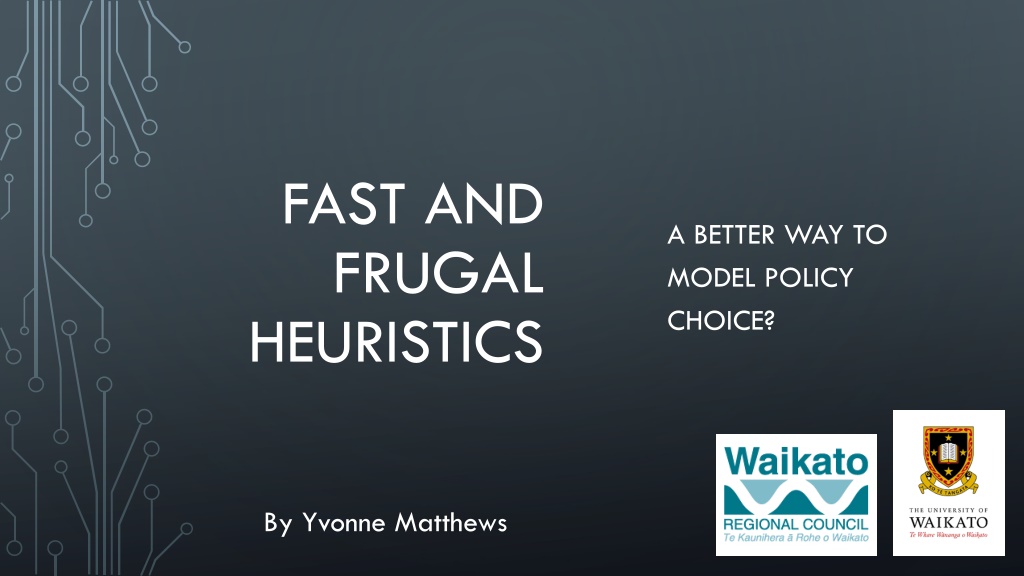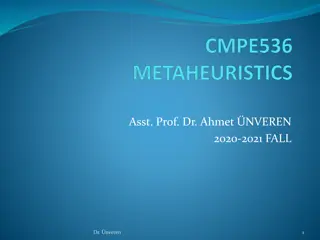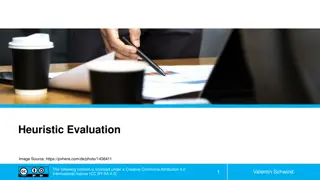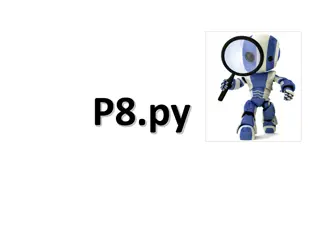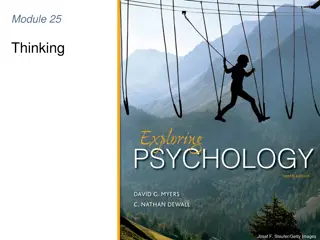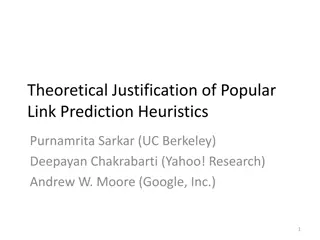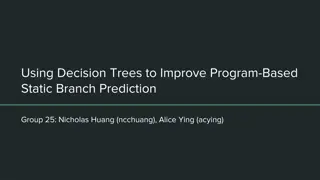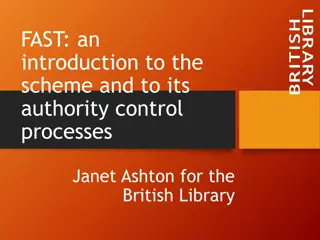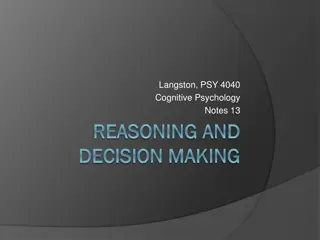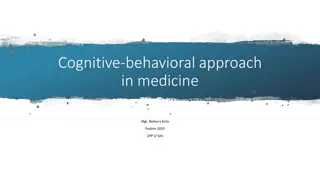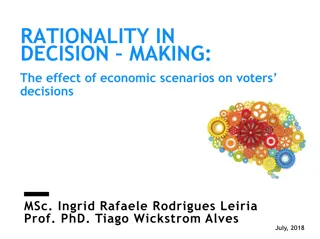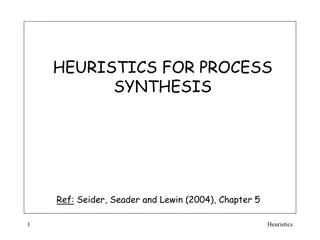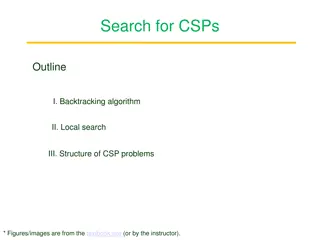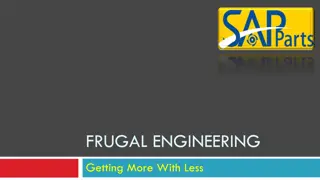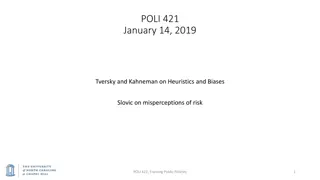Understanding Fast and Frugal Heuristics in Decision Making
Exploring the concept of fast-and-frugal heuristics as a better way to model policy choice for decision making in uncertain environments. The discussion covers uncertainty terminology, introduction to heuristics, how people actually make decisions, and models of decision making incorporating fast-and-frugal trees.
Download Presentation

Please find below an Image/Link to download the presentation.
The content on the website is provided AS IS for your information and personal use only. It may not be sold, licensed, or shared on other websites without obtaining consent from the author. Download presentation by click this link. If you encounter any issues during the download, it is possible that the publisher has removed the file from their server.
E N D
Presentation Transcript
FAST AND FRUGAL HEURISTICS A BETTER WAY TO MODEL POLICY CHOICE? By Yvonne Matthews
BACKGROUND For the past year I have been working on a post-doc project to improve understanding about how managers decide to fund innovation projects when the future is uncertain There are plenty of prescriptive theories about how managers shouldmake decisions. But managers usually don t have enough information to apply these frameworks. Often, they can t even quantify the risks or potential rewards Does this situation sound familiar to anyone in environmental management?
UNCERTAINTY TERMINOLOGY What analysis methods were designed for Risk When we know the probability of each possible future state (e.g. gambling) Uncertainty When we know the possible future states, but not the probabilities (e.g. sea level rise) Deep uncertainty When we don t know the possible future states (e.g. new technologies or diseases) Ambiguity When we can t even agree on the current state
INTRODUCING HEURISTICS A heuristic is a decision rule that is not necessarily optimal. It may involve mental shortcuts or use of less-than-full information Introduced by an economist (Herbert Simon) and appropriated by psychologists (Tversky, Kahneman, Gigerenzer) 2 research streams: Normative how people actually make decisions Prescriptive how people should make decisions
HOW PEOPLE ACTUALLY MAKE DECISIONS People frequently depart from the standard model of utility maximisation Behavioural labels include: satisficing, take-the-best, elimination-by-aspects, lexicography When do people follow the standard of rationality ? When making decisions that they encounter frequently, and have experienced the consequences When do they not? When the options are unfamiliar to them When their preferences have thresholds (i.e. minimum acceptable quality) When they are uncertain about the outcomes When it s too difficult When they are short of time When they don t care
MODELS OF DECISION MAKING Random utility choice models based on rational expectations are still widely used. Why? Numerous extensions to accommodate non-standard behaviour In aggregate, it approximates reality Choice experiments are designed to encourage standard behaviour An alternative: fast-and-frugal trees Built from highly flexible non-linear building blocks of disjunctions and conjunctions Accounts for the bounded nature of cognition and information Useful for understanding the microeconomic foundations of decisions
ALL ABOUT FAST-AND-FRUGAL TREES They are fast because they allow a decision as soon as the crucial important information has been evaluated They are frugal because only one piece of information is evaluated at each branch For the psychological justification see Gigerenzer et al. (1990s onwards) For the specification see Martignon et al. (2003 & 2008) For the connection with economic theory see Braithwaite et al. (2017) To try it yourself use the R package FFTrees (Phillips et al., 2017)
BACK TO THE MANAGER EXPERIMENT For the project about business innovation decisions I developed a choice experiment and we got actual managers to answer it I fitted both random-utility choice models AND fast-and-frugal trees to the choice data Compared predictive accuracy Compared the decision rules used with management theory
EXAMPLE FFT OUTPUT If individuals involved in this project have a successful track record, decide Yes. If Individuals involved in the other project do not have no track record, decide No. This project does has a substantial cost reduction, decide Yes, otherwise, decide No.
Predictive accuracy 100% 95% KEY RESULTS 90% 85% FFT had better average predictive accuracy >15 years FFTree accuracy 80% 10-15 years FFT was more likely to be a better fit for experienced managers 75% 5-10 years <5 years 70% 45 degrees 65% Experienced managers used less information and had more stable rules 60% 55% 50% 50% 60% 70% MNL accuracy 80% 90% 100%
WHEN HEURISTICS ARE RATIONAL Using full information (e.g. MNL) fits existing data better But simple rules make better out-of-sample predictions Evidence from finance, business, medical diagnoses, forecasting Ecological rationality requires evaluation and adaption
When we want to understand choices at a micro level WHEN SHOULD WE USE FFTREES E.g. support for a policy When non-linear thresholds are expected E.g. constraints or minimum acceptable levels of water quality TO EXPLAIN OR PREDICT CHOICE? When the context is ambiguous or uncertain E.g. people ignore information that doesn t fit their beliefs
Implementation: does the decision need to be made quickly, without computational aid? FFTrees are easy to remember and use WHEN SHOULD WE USE FFTREES FOR MAKING DECISIONS? Costs: is it costly to gather relevant information? FFTrees are frugal Transparency: is it important to understand how the algorithm works? FFTrees can be explained with simple rules Easy to check if it fails Prediction accuracy: is it similar or better than alternatives? FFTrees are robust when data is scarce or highly variable
WHEN NOT TO USE FFTREES? When there are many weakly predictive but related cues When another model has been proven better in this context
WHAT NEXT? The project about managers is wrapping up Next I am going to apply the same methods and tools to environmental policy decisions I am now designing a choice experiment to analyse: Policy developers preferences for economic instruments Decision rules used by experienced vs. graduate policy developers Decision rules used when outcomes are relatively certain vs. deeply uncertain
FINAL WORDS: HOW TO BE AN ECOLOGICALLY RATIONAL ECONOMIST: cross-validate evaluate adapt
ABSTRACT Traditional economic theory would have us believe that rational decision-making requires full information and complete evaluation of all options. We have long known this is not how people usually make decisions. There is a mountain of literature about heuristics (simple rules) and biases which have condescendingly explained heuristics as shortcuts people use when they lack time or mental capacity. However, the real world often has too much uncertainty and ambiguity to make optimal decisions even with advanced computer models supporting our limited brains. Predictive accuracy involves a trade-off between bias and variance, with more complex models having higher variance. Recent studies have found - counter-intuitively - that simple decision rules using key pieces of information can out-perform optimization models using full information. Heuristic models not only explain choices better, but also lead to better and more robust outcomes in many situations. Evidence of this has been reported in areas such as financial investment, medicine, management, and marketing. What s more, expert decision-makers tend to use less information than novices. This new understanding of rationality is known as ecological rationality and requires learning and adapting decision strategies to the decision environment. What are the implications of this paradigm shift for environmental and resource economics? Environmental issues are synonymous with uncertainty and ambiguity, so traditional risk analysis and optimization models may not be ecologically rational . In this presentation I demonstrate the use of an R package to fit Fast and Frugal Trees - a heuristic classification tool - to a choice experiment data set. I show how to identify the rules individuals used, and compare predictive accuracy with the MNL family of choice models. Finally, I describe the policy situations under which heuristic models might provide useful insights, and their limitations.
